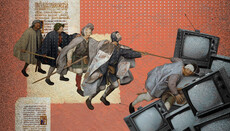Attention – communication between pain and suffering

During the post-feast of the Exaltation of the Cross, we reflect on the nature of pain and suffering. Practical techniques for those living in conditions of constant stress.
The entire week is under the shadow of the post-feast of the Exaltation of the Holy Cross. Therefore, let's talk about some concepts related to pain and suffering, as well as how some of this knowledge can be applied in practice.
The difference between pain and suffering
First of all, it is necessary to learn to understand how pain differs from suffering. Pain is a physical or emotional sensation. It arises in the body as a reaction to illness or injury, or in the psyche when disturbing events occur. Suffering is our reaction to this pain. It is primarily associated with our thoughts and emotions about this pain. For example, fear, anxiety, anger, or self-pity are sufferings related to pain.
The communication between pain and suffering is our attention. It is what turns physical pain into psychological suffering.
If our attention is completely absorbed by the pain, suffering becomes inevitable. Conversely, if we can distract ourselves from the pain, its intensity and accompanying suffering may decrease. Moreover, a person can experience pain without suffering when they see some higher meaning in it.
Dispassion is the ideal form of enduring any suffering. But achieving such a state is possible only when there are no attachments to anything earthly in the soul, and primarily to one's own body. For people living in the world, having children and loved ones, achieving dispassion is practically impossible. Therefore, to better cope with suffering, one must learn to manage their attention as much as possible. First of all, be able to distract oneself with something else and not dwell on one's problems. Another way is to accept the pain. In this case, we learn to notice our thoughts and sensations, including painful ones, as temporary phenomena, as an integral part of our life, as a necessary condition for our salvation.
One of the ways to master attention is through reflection. This word is sometimes perceived by Orthodox believers as something hostile to our tradition. But what we are talking about has nothing to do with this. Every time we read the Gospel and ponder its content, we engage in spiritual reflection.
Modern psychology regarding pain suggests actively directing attention to other parts of the body or to external sensations not related to pain.
For example, you can focus on your breathing, on the feeling of a cool breeze on your skin, or on how your toes move. This helps redirect the "flow" of attention from the painful area to something neutral or pleasant. It is important to understand that shifting attention is not a denial of pain. The pain still exists, but our attitude towards it changes, and this significantly reduces the level of suffering.
Stabilization techniques in a crisis situation
Separately, I would like to focus on exercises that residents of frontline areas need to memorize. But it would be good if those who are far from the combat zone also become familiar with them.
Stress during a bombing or shelling is an acute reaction, and the main thing is to stabilize yourself here and now.
But it is important to understand that in a state of post-traumatic stress disorder, a person is in dire need of professional psychological help!
The methods described below are aimed at bringing your consciousness out of a state of panic into reality and calming the nervous system.
1. Returning to the "here and now"
Your goal is to concentrate on physical sensations to distract the brain from anxiety.
The "5-4-3-2-1" rule:
- 5 things you see (cracks in the wall, your shoes, a backpack).
- 4 things you feel (the hardness of the floor, the fabric of your clothes, cold or warmth, your hand).
- 3 things you hear (your breathing, noise, someone else's voice).
- 2 things you smell (the smell of dampness, the smell of your scarf).
- 1 thing you can taste.
Contact with the ground or floor:
Focus on your feet. Feel how they stand on the floor. Try to press your feet firmly into the floor, tensing your leg muscles, and then relax them. Repeat several times.
Tactile contact:
Touch an object nearby (a wall, a jacket, water) and describe it to yourself: "Hard", "Cold", "Rough", "Soft".
2. Breathing exercises for calming
Breathing is something you can control, and it quickly sends a signal to the brain that the threat has passed.
Breathing 4-2-6:
- Slow inhale for the count of 4 (using your abdomen, not your chest).
- Hold your breath for the count of 2 (or do not pause if it is difficult).
- Slow exhale for the count of 6 (or 8), trying to make the exhale 1.5-2 times longer than the inhale.
Repeat 5-10 times. Focus only on the count.
"Square" breathing:
Inhale for 4 counts, hold for 4 counts, exhale for 4 counts, hold for 4 counts.
3. Working with the body
Stress causes muscles to contract. Exercises will help relieve this tension. Alternately tense and sharply relax muscle groups:
- Tightly clench your fists, hold for 5 seconds, then sharply release.
- Tense the muscles of your face. Tense your shoulders by pulling them up to your ears, hold, then sharply drop them. Tense your legs by pressing your heels into the floor, then relax.
4. Affirmations
Restore the timeline: Say to yourself the facts: "There was a siren, we are in shelter. There is shelling now. We are safe. Sooner or later it will end. I will endure." Use affirmations: "I am here", "I am safe", "I will cope", "My body is strong".











